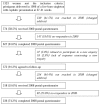Urinary incontinence 4 and 12 years after first delivery: risk factors associated with prevalence, incidence, remission, and persistence in a cohort of 236 women
- PMID: 24132982
- PMCID: PMC5065622
- DOI: 10.1002/nau.22498
Urinary incontinence 4 and 12 years after first delivery: risk factors associated with prevalence, incidence, remission, and persistence in a cohort of 236 women
Abstract
Aims: Our aim was to study risk factors associated with prevalence, incidence, and remission of UI 4 and 12 years after first delivery.
Methods: Seven hundred seventy-four nulliparous women who gave birth in 1996 in two French maternity units at term received a questionnaire about their urinary symptoms in 2000 and again in 2008. Two hundred thirty-six women returned a questionnaire about UI 4 and 12 years after first delivery. Four groups of women were built: (A) women continent 4 and 12 years after first delivery; (B) women continent at 4 and incontinent at 12 years; (C) women incontinent at 4 and continent at 12 years; and (D) women incontinent at 4 and 12 years. Multivariate logistic regressions were used to determine risk factors of UI prevalence (groups B + D vs. A + C), incidence (B vs. A), remission (C vs. D), and onset of UI (D vs.
B) results: Factors associated with UI 12 years after first pregnancy were: BMI (OR = 1.17 [95%CI: 1.04-1.32], by 1 kg/m(2) ) and increasing BMI (1.43 [1.19-1.73]), first child's weight (1.08 [1.001-1.16], by 100 g) and UI during first pregnancy (3.77 [1.83-7.76]). Factors associated with UI incidence were age at first delivery (0.86 [0.75-0.98]) and high BMI (1.24 [1.05-1.45]). Increasing BMI, UI during first pregnancy, and heavy first child reduce the likelihood of UI remission (0.37 [0.20-0.68], 0.11 [0.02-0.63], and 0.73[0.59-0.91], respectively).
Conclusions: UI during first pregnancy could be indicative of individual susceptibility to UI. Obesity appears to be a modifiable factor for remission of UI in women.
Keywords: age; body mass index; mode of delivery; parity; urinary incontinence.
© 2013 Wiley Periodicals, Inc.
Figures


References
-
- Rortveit G, Daltveit AK, Hannestad YS, Hunskaar S. Urinary incontinence after vaginal delivery or cesarean section. N Engl J Med. 2003;348:900–7. - PubMed
-
- Viktrup L, Rortveit G, Lose G. Risk of stress urinary incontinence twelve years after the first pregnancy and delivery. ObstetGynecol. 2006;108:248–54. - PubMed
-
- MacArthur C, Glazener CM, Wilson PD, Lancashire RJ, Herbison GP, Grant AM. Persistent urinary incontinence and delivery mode history: a six-year longitudinal study. BJOG. 2006;113:218–24. - PubMed
-
- MacArthur C, Glazener C, Lancashire R, Herbison P, Wilson D on behalf of the ProLong study group. Exclusive caesarean section delivery and subsequent urinary and faecal incontinence: a 12-year longitudinal study. BJOG. 2011;118:1001–7. - PubMed
MeSH terms
LinkOut - more resources
Full Text Sources
Other Literature Sources
Medical

